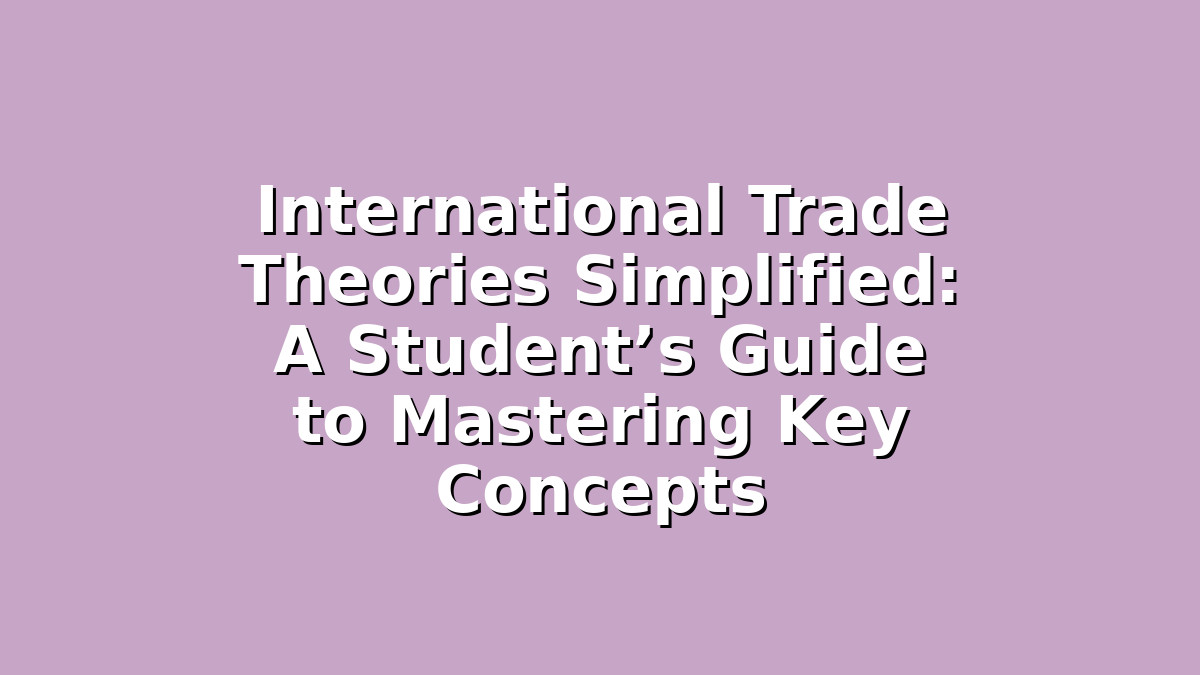If you’re a student preparing for exams in economics, business, or international relations, understanding international trade theories can sometimes feel overwhelming. Terms like comparative advantage, Heckscher-Ohlin theory, or the product life cycle model may seem complex at first glance. But don’t worry! This article will simplify these important theories and provide helpful study tips to help you grasp and remember them effectively. By the end of this guide, you’ll have a clear understanding of the core ideas behind international trade and some practical strategies to ace your exams.
Introduction to International Trade Theories
International trade theories explain why countries engage in trade, what goods they export or import, and how trade benefits economies globally. These theories help us understand the patterns of trade and the factors that influence them. For students, mastering these theories is crucial because they form the foundation for more advanced topics like trade policy, globalization, and economic development.
Let’s break down three major international trade theories in a straightforward way, along with study tips that will help you retain the information and apply it confidently in your exams.
—
1. Classical Trade Theories: Absolute and Comparative Advantage
Concept Overview:
The classical trade theories were introduced by economists like Adam Smith and David Ricardo. The most fundamental ideas are:
– Absolute Advantage (Adam Smith): A country should produce and export goods that it can produce more efficiently than any other country, meaning it uses fewer resources or produces more output with the same resources.
– Comparative Advantage (David Ricardo): Even if a country does not have an absolute advantage, it should specialize in producing goods for which it has the lowest opportunity cost compared to other countries. This concept explains why trade can be beneficial even if one country is more efficient at producing everything.
Why It Matters:
These theories form the backbone of international economics. Understanding comparative advantage helps explain why countries trade and how they gain from trade, which is essential for exam questions involving trade benefits and specialization.
Study Tips:
– Use Real-Life Examples: Think about countries you know, like how Japan exports cars or Bangladesh exports textiles. Relate these examples to the concept of comparative advantage.
– Create Comparison Charts: Make tables comparing opportunity costs between countries for different goods. Visual aids help in memorizing how comparative advantage works.
– Practice Graphs: Draw production possibility frontiers (PPFs) and see how trade shifts consumption possibilities beyond the PPF.
—
2. Heckscher-Ohlin Theory: Factor Endowments and Trade Patterns
Concept Overview:
The Heckscher-Ohlin (H-O) theory builds on classical ideas but focuses on resources. It emphasizes that countries export products that use their abundant and cheap factors of production intensively, and import products that use their scarce factors intensively.
– If a country has more capital than labor, it will export capital-intensive goods.
– If a country has more labor than capital, it will export labor-intensive goods.
Why It Matters:
The H-O theory explains the patterns of trade based on resource availability, which helps you understand why countries produce and trade different types of goods beyond the basic efficiency arguments.
Study Tips:
– Memorize Key Terms: Understand what “factor endowments,” “capital-intensive,” and “labor-intensive” mean.
– Use Diagrams: Draw simple supply and demand curves for factors of production and relate them to export and import goods.
– Summarize Key Points in Flashcards: Write short, clear statements of the theory’s main ideas and quiz yourself regularly.
—
3. Modern Trade Theories: Product Life Cycle and New Trade Theory
Concept Overview:
Modern trade theories explain trade patterns in a globalized and technological world.
– Product Life Cycle Theory (Raymond Vernon): New products are first produced and exported by the innovating country. As the product matures and production standardizes, production spreads to other countries, including developing nations.
– New Trade Theory: It highlights the role of economies of scale and network effects. Some industries benefit from large-scale production, leading to market dominance by a few countries or firms.
Why It Matters:
These theories explain real-world phenomena such as why the US exports innovative technology products initially but later imports cheaper versions from other countries. They also help you understand the importance of innovation and scale in trade.
Study Tips:
– Relate to Current Events: Think about products like smartphones or electric cars and how their production has shifted globally.
– Make Timelines: For the product life cycle, create a timeline showing stages from innovation to mass production abroad.
– Discuss with Peers: Explain these concepts to friends or study groups; teaching others improves your own understanding.
—
Conclusion: Your Path to Mastering International Trade Theories
International trade theories may seem like a lot to take in, but by breaking them down into manageable parts and using active study techniques, you can master these concepts with confidence. Remember, the key is to connect theory with real-world examples and to practice regularly using charts, graphs, and flashcards.
Start by focusing on the basics like comparative advantage, then build up to more complex ideas like the Heckscher-Ohlin theory and modern trade models. Use your study time wisely—mix reading with drawing diagrams, discussing with peers, and testing yourself. With persistence and the right strategies, international trade theories will no longer seem daunting but will become a powerful tool to understand the global economy and excel in your exams.
Good luck, and keep going—you’ve got this!
—

Responses